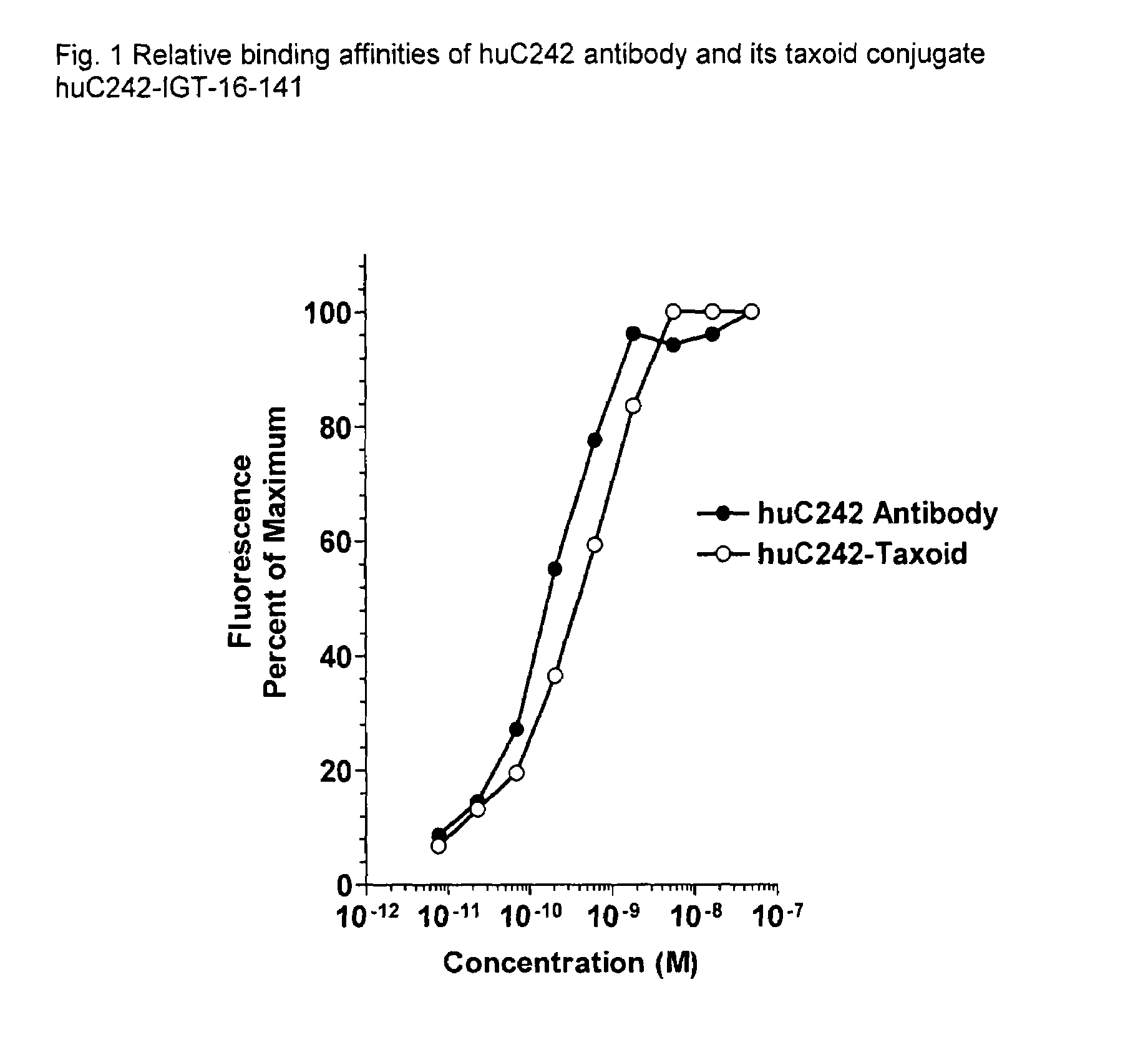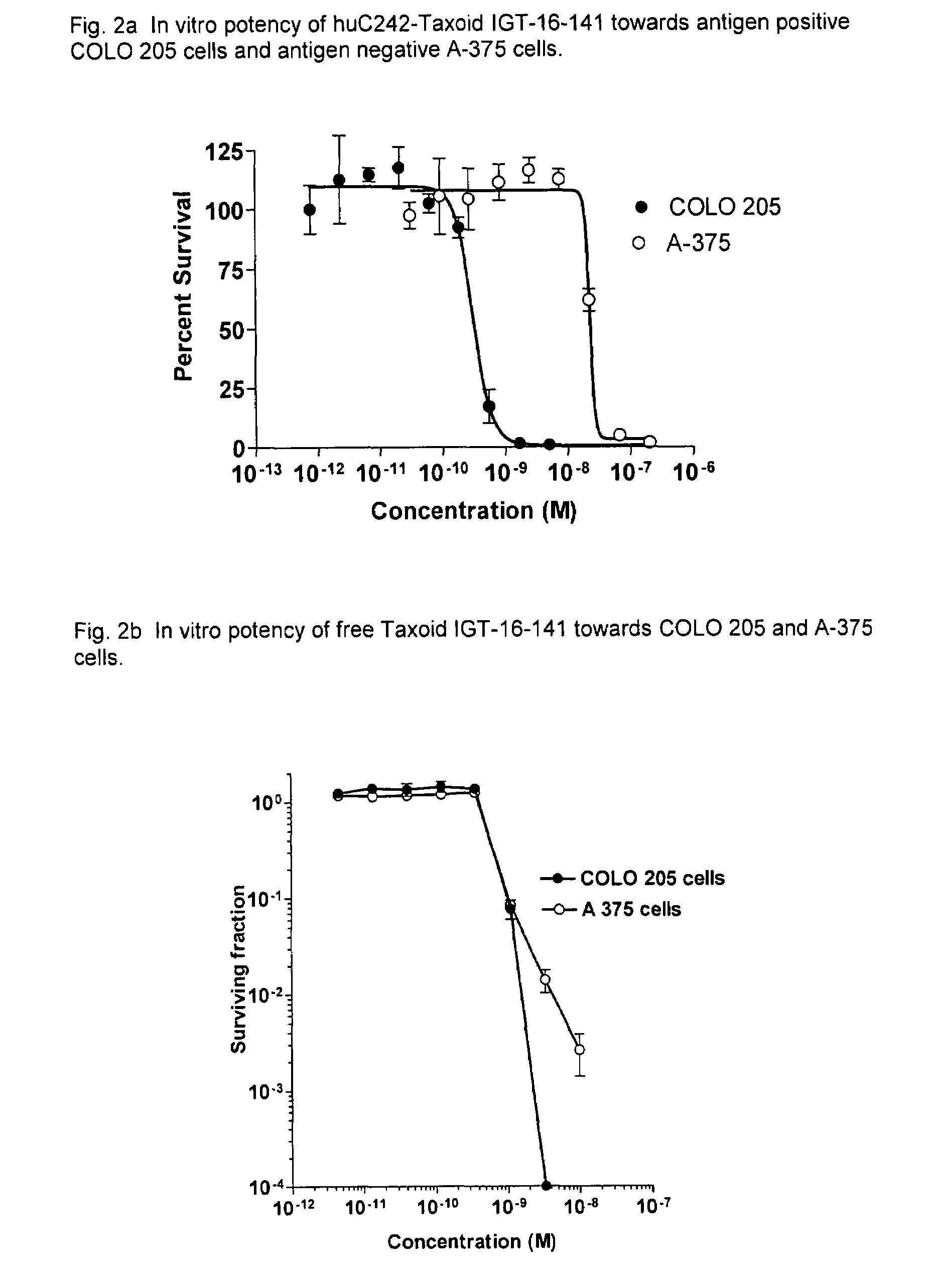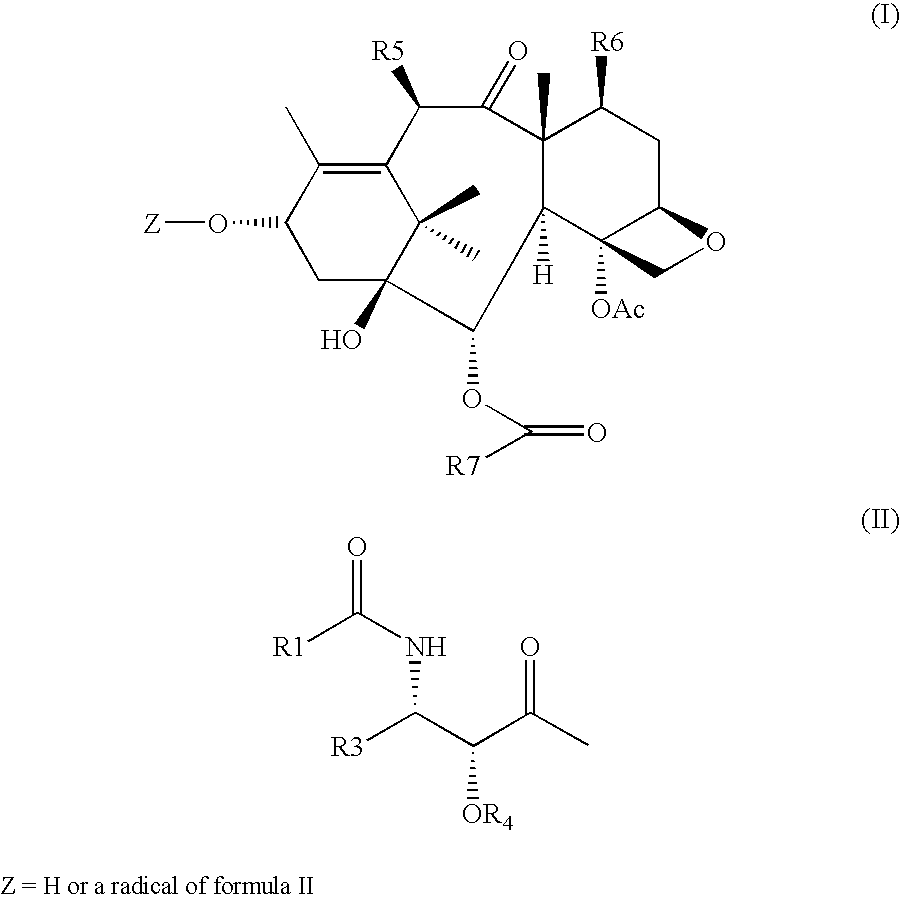Cytotoxic agents comprising new C-2 modified taxanes
a cytotoxic agent and taxanoid technology, applied in the field of new cytotoxic agents, can solve the problems of ineffective mechanism by which drug molecules are released from antibodies, difficult to modify existing drugs without reducing their cytotoxic potential, and rarely achieved the same cytotoxic potency of free unconjugated drugs. to achieve the effect of effective us
- Summary
- Abstract
- Description
- Claims
- Application Information
AI Technical Summary
Benefits of technology
Problems solved by technology
Method used
Image
Examples
embodiment 1
R5 is the Linking Group
[0038]Z is H or a radical of II
[0039]R1 is an optionally substituted aryl or heterocyclic radical, alkyl having from 1 to 10 carbon atoms, alkynyl or alkenyl having from 2 to 10 carbon atoms, cycloalkyl or cycloalkenyl having from 3 to 10 carbon atoms, —OR2 or a carbamate formed from any of said alkyl having from 1 to 10 carbon atoms, alkynyl or alkenyl having from 2 to 10 carbon atoms, cycloalkyl or cycloalkenyl having from 3 to 10 carbon atoms, or optionally substituted aryl or heterocyclyl radical
[0040]R2 is alkyl having from 1 to 10 carbon atoms, alkynyl or alkenyl having from 2 to 10 carbon atoms, cycloalkyl or cycloalkenyl having from 3 to 10 carbon atoms, optionally substituted aryl or heterocyclic radical
[0041]Preferably, R1 is t-butoxy, crotyl, dimethylacrylyl, isobutenyl, hexenyl, cyclopentenyl, cyclohexenyl, furyl, pyrrolyl, thienyl, thiazolyl, imidazolyl, pyridyl, morpholino, piperidino, piperazino, oxazolyl, indolyl, benzofuranyl or benzothienyl.
[...
embodiment 2
R1 is the Linking Group
[0063]Z is a radical of II
[0064]R1 is the linking group.
[0065]Suitable linking groups are well known in the art and include disulfide groups, thioether groups, acid labile groups, photolabile groups, peptidase labile groups and esterase labile groups. Preferred are disulfide groups and thioether groups.
[0066]When the linking group is a thiol- or disulfide-containing group, the side chain carrying the thiol or disulfide group can be linear or branched, aromatic or heterocyclic. One of ordinary skill in the art can readily identify suitable side chains.
[0067]Specific examples of the thiol- or disulfide-containing substituents include —(CR15R16)m(CR17R18)n(OCH2CH2)ySZ′, —O(CR15R16)m(CR17R18)n(OCH2CH2)ySZ′, —(CR15R16)m(CR19═CR20)(CR17R18)m(OCH2CH2)ySZ′, —O—(CR15R18)m(CR19═CR20)(CR17R18)m(OCH2CH2)ySZ′, NR14(CR15R16)m(CR17R18)n(OCH2CH2)ySZ′, -phenyl-X′SZ′, -furyl-X′SZ′, -oxazolyl-X′SZ′, thiazolyl-X′SZ′, -thienyl-X′SZ′, -imidazolyl-X′SZ′, -morpholino-X′SZ′, -piperazi...
embodiment 3
R3 is the Linking Group
[0085]Z is a radical of II
[0086]R1 is an optionally substituted aryl or heterocyclic radical, alkyl having from 1 to 10 carbon atoms, alkynyl or alkenyl having from 2 to 10 carbon atoms, cycloalkyl or cycloalkenyl having from 3 to 10 carbon atoms, —OR2 or a carbamate formed from any of said alkyl having from 1 to 10 carbon atoms, alkynyl or alkenyl having from 2 to 10 carbon atoms, cycloalkyl or cycloalkenyl having from 3 to 10 carbon atoms, or optionally substituted aryl or heterocyclyl radical
[0087]R2 is alkyl having from 1 to 10 carbon atoms, alkynyl or alkenyl having from 2 to 10 carbon atoms, cycloalkyl or cycloalkenyl having from 3 to 10 carbon atoms, optionally substituted aryl or heterocyclic radical
[0088]Preferably, R1 is t-butoxy, crotyl, dimethylacrylyl, isobutenyl, hexenyl, cyclopentenyl, cyclohexenyl, furyl, pyrrolyl, thienyl, thiazolyl, imidazolyl, pyridyl, morpholino, piperidino, piperazino, oxazolyl, indolyl, benzofuranyl or benzothienyl.
[0089]...
PUM
 Login to View More
Login to View More Abstract
Description
Claims
Application Information
 Login to View More
Login to View More - R&D
- Intellectual Property
- Life Sciences
- Materials
- Tech Scout
- Unparalleled Data Quality
- Higher Quality Content
- 60% Fewer Hallucinations
Browse by: Latest US Patents, China's latest patents, Technical Efficacy Thesaurus, Application Domain, Technology Topic, Popular Technical Reports.
© 2025 PatSnap. All rights reserved.Legal|Privacy policy|Modern Slavery Act Transparency Statement|Sitemap|About US| Contact US: help@patsnap.com



